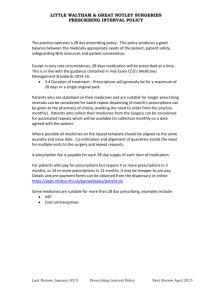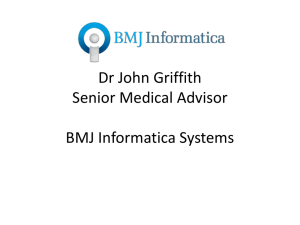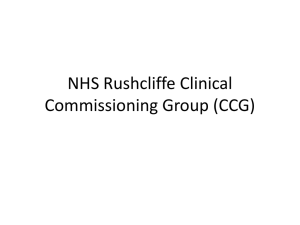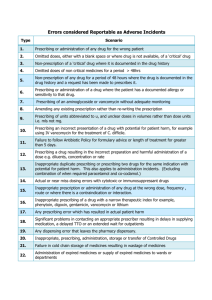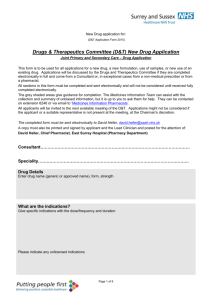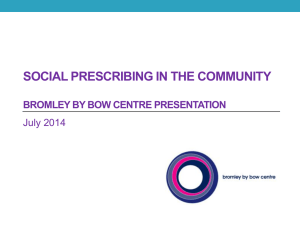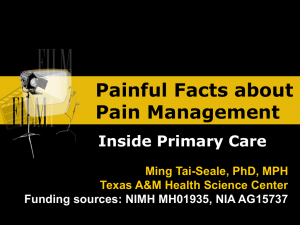Empowering Patients * Recognising the skills
advertisement
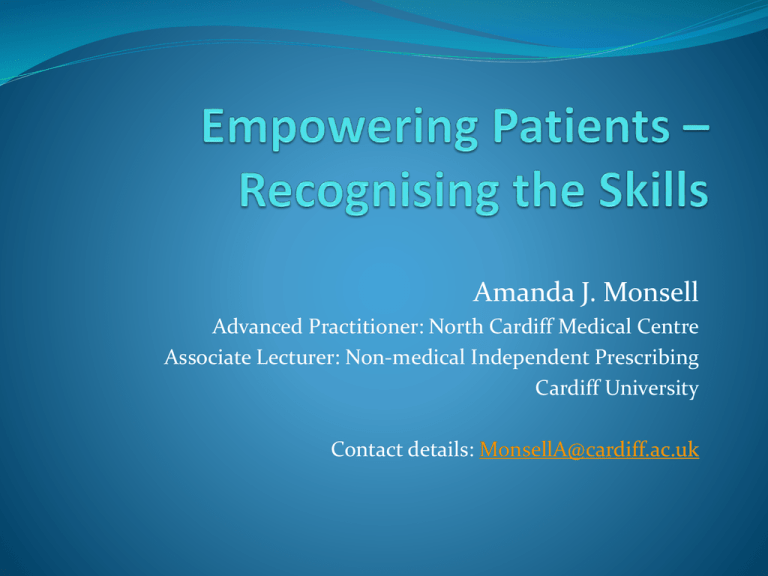
Amanda J. Monsell Advanced Practitioner: North Cardiff Medical Centre Associate Lecturer: Non-medical Independent Prescribing Cardiff University Contact details: MonsellA@cardiff.ac.uk Learning Outcomes To be familiar with the key principle of concordance in non-medical independent prescribing. To recognise the barriers to information-giving within a consultation To highlight availability of patient decision making tools Empowerment Patient empowerment is considered a paramount skill in the prescribing arena It can be defined as: 1. “To give power or authority to – to authorize” 2. “To give ability to; enable or permit” Sinclair et al 1999 pp. 468 Empowerment and Prescribing Communication Patient participation Awareness of patients concerns Shared-decision making Concordance Acceptance that sometimes the patient may want to decline treatment Communication Good communication and patient participation is the crux of the shared decision-making process1;2 but how is this best achieved? One needs to consider several factors Patient’s capacity to retain and recollect information Their understanding and assimilation of that information The impact of consultation time on what are potentially life-long decisions Capacity Memory for recollection of information is poor and worsened by anxiety and age1 Ability to remember information is small 40-80% of information given in a consultation is forgotten immediately 2 The more information given, the more is actually forgotten2 Understanding To achieve patient understanding and true concordance requires time and the formation of a partnership between the clinician and the patient.3 Equipoise is advocated from the clinician demonstrating no set opinion4 This is highlighted as essential especially with the increase in poly-pharmacy2 Consideration must be given as to how understanding can be best achieved Time Implications Within a consultation there must be recognition that the patient may need time to reflect upon the information given after all 10-15 minutes isn’t long! Allowing a patient to go home and discuss the options with family and friends can help the process of informed decision making6 Having easy access to patient information leaflets assists the process7 Barriers to Adherence Anxiety Poor relationship and using “medic speak”8 Depression (use of PHQ-2 assessment for patients with chronic diseases in primary care)9 Dictatorial or paternalistic approach to the consultation in some instances Age and Gender10 Decision-making Aids Media releases Internet Patient Information leaflets7; 11; 12 Written Pictorial11, 12 Videos / DVD13 Verbal advice7; 14 Expert patient groups Patient Participation How do we get patient’ “involved”? Respect the patient’s opinion Discuss their concerns Continuity of care Assess a patient’s literacy skills Work as a team Empowerment Communication Truthfulness Back up verbal information with written leaflets Build the relationship with the patient Plan review appointment but allow open door access if problems arise References 1. 2. 3. 4. 5. 6. NICE (2009). Medicines adherence. Involving patients in decision about prescribed medicines and supporting adherence. NICE Clinical Guideline 76. London, National Institute for Health and Clinical Excellence. Clyne, W., Granby, T., Picton, C. (2007). A competency framework for shared decision-making with patients: Achieving concordance for taking medicines. Retrieved from [last accessed 02/08/2011] Hook, M. L. (2006) Partnering with patients – a concept ready for action Journal of Advanced Nursing 56(2) pp. 133-143. Kessels, R. P. C. (2003). “Patients’ memory for medical information.” J R Soc Med 96(5): pp. 219-222. McGuire, L. C. (1996). “Remembering what the doctor said: organization and adults’ memory for medical information.” Exp Aging Res 22(4): pp. 403-428. Elwyn, G., Edwards, A. and Britten, N. (2003). ““Doing prescribing”: how doctors can be more effective.” BMJ 327(7419): pp. 864-867. References Coulter, A. and Ellins, J. (2007). “Effectiveness of strategies for informing, educating and involving patients.” BMJ 335(7609): pp.24-27. 8. LaRosa, J. H. and LaRosa, J. C. (2000) Enhancing drug compliance in lipid-lowering treatment. Arch Fam Med 9(10) pp. 1169-1175 9. Li, C., Friedman, B., Conwell, Y. and Fiscella, K. (2007) Validity of the Patient Health Questionnaire 2 (PHQ-2) in identifying major depression in older people. J Am Geriatr Soc 55(4) pp. 596-602 10. Carter, S. Taylor, D. and Levenson, R. (2005) A question of choice – compliance in medicine taking – a preliminary review (3rd ed.) [Accessed: 06.09.2009: http://www.keele.ac.uk/schools/pharm/npcplus/medicinespar tner/documents/research-qoc-compliance.pdf 7. References Houts, P. S., Bachrach, R., Witmer, J. T., Tringali, C. A., Bucher, J. A. and Localio, R.A. (1998). “Using pictographs to enhance recall of spoken medical instructions.” Patient Educ Couns 35(2): pp. 83-88. 12. Edwards, A., Elwyn, G. and Mulley, A. (2002). “Explaining risks: turning numerical data into meaningful pictures.” BMJ 324(7341): pp. 827-30. 13. Barkhordar, A., Pollard, D. and Hobkirk, J. A. (2000) A comparison of written and multimedia material of informing patients about dental implants. Dent Update 27(2) pp. 80-84 14. Hege, A. C. G. and Dodson, C. S. (2004). “Why Distinctive Information Reduces False Memories: Evidence for Both Impoverished Relational-Encoding and Distinctiveness of Heuristic Accounts.” Journal of Experimental Psychology: Learning, Memory& Cognition 30(4): pp. 787-795. 11.

